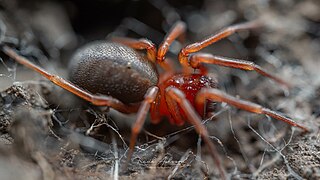
Periegops is a genus of spiders with six eyes instead of the usual eight. It is the only genus in its family (Periegopidae) and has three described species. It was long considered to be a member of Sicariidae or Segestriidae until Raymond Forster elevated it to the family level in 1995.

Trite auricoma, commonly known as the golden-brown jumping spider, is a species of jumping spider endemic to New Zealand.

Anoteropsis aerescens is a species of wolf spiders that is endemic to New Zealand.

Dolomedes schauinslandi or the Rangatira spider is a large spider of the family Pisauridae. It is only found on South East Island (Rangatira), Houruakopara and Mangere Islands in the Chatham Islands, New Zealand. It is one of New Zealand's largest and rarest spiders.
Periegops keani is a species of spider in the genus Periegops that is endemic to the North Island of New Zealand.

Diaea ambara is a species of crab spider that is endemic to New Zealand.

Acroaspis decorosa is a species of orbweaver spider that is endemic to New Zealand.
Waiporia algida is a species of Orsolobidae that is endemic to New Zealand.

Colaranea viriditas is a species of orb-weaver spider that is endemic to New Zealand.
Haplinis diloris is a species of sheet weaver spider endemic to New Zealand.
Haplinis fucatinia is a species of sheet weaver spider endemic to New Zealand.
Haplinis mundenia is a species of sheet weaver spider endemic to New Zealand.
Haplinis rufocephala is a species of sheet weaver spider endemic to New Zealand.
Pseudafroneta incerta is a species of sheet weaver spider endemic to New Zealand.
Tekella absidata is a species of Cyatholipidae spider endemic to New Zealand.
Tekella nemoralis is a species of Cyatholipidae spider endemic to New Zealand.
Kapanga solitaria is a species of Hahniidae spider endemic to New Zealand.

Rhomphaea urquharti is a species of cobweb spider that is endemic to New Zealand.
Theridion ampliatum is a species of Theridiidae that is endemic to New Zealand.
Anoteropsis adumbrata is a species of Lycosidae spider that is endemic to New Zealand.













